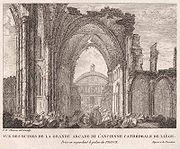
Roman Catholic Diocese of Liège
Encyclopedia
The Roman Catholic Diocese of Liège
is a diocese
of the Latin Rite of the Roman Catholic church
in Belgium
. The diocese was erected in the 4th century, and has a long and complicated history. Currently the diocese is a suffragan of the Archdiocese of Mechelen-Brussels, and is presently served by Bishop Alyosius Jousten, appointed in May 2001.
, and confirmed in 1801 by a Concordat
co-signed by Napoléon Bonaparte and Pope Pius VII
. The new diocese, erected 10 April 1802, included the two of Ourte and Meuse-Inférieure
, with certain parishes of the des Forêts
. In 1818, it lost a certain number of cantons, ceded to Prussia
.
 After the establishment of the United Kingdom of the Netherlands
After the establishment of the United Kingdom of the Netherlands
the diocese comprised the provinces of Liège
and Limburg. On 6 May 1838, Mgr Van Bommel divided the Province of Liège into two deaneries. In 1839, the diocese lost those parishes which were situated in Dutch Limburg
. In 1967, the Dutch-speaking parishes of the diocese formed the newly erected Diocese of Hasselt. The present Diocese of Liège, suffragan to the Archdiocese of Mechlin–Brussels, consists of 525 parishes with 543 priests and has a population of 1,023,506 , the majority (Walloons
) speaking French
; the minority, German
in the German-speaking Community of Belgium
. The present territory of the diocese coincide with the Province of Liège
.
Liège
Liège is a major city and municipality of Belgium located in the province of Liège, of which it is the economic capital, in Wallonia, the French-speaking region of Belgium....
is a diocese
Diocese
A diocese is the district or see under the supervision of a bishop. It is divided into parishes.An archdiocese is more significant than a diocese. An archdiocese is presided over by an archbishop whose see may have or had importance due to size or historical significance...
of the Latin Rite of the Roman Catholic church
Roman Catholic Church
The Catholic Church, also known as the Roman Catholic Church, is the world's largest Christian church, with over a billion members. Led by the Pope, it defines its mission as spreading the gospel of Jesus Christ, administering the sacraments and exercising charity...
in Belgium
Belgium
Belgium , officially the Kingdom of Belgium, is a federal state in Western Europe. It is a founding member of the European Union and hosts the EU's headquarters, and those of several other major international organisations such as NATO.Belgium is also a member of, or affiliated to, many...
. The diocese was erected in the 4th century, and has a long and complicated history. Currently the diocese is a suffragan of the Archdiocese of Mechelen-Brussels, and is presently served by Bishop Alyosius Jousten, appointed in May 2001.
History of the diocese
The original diocese survived until suppression under the RevolutionFrench Revolution
The French Revolution , sometimes distinguished as the 'Great French Revolution' , was a period of radical social and political upheaval in France and Europe. The absolute monarchy that had ruled France for centuries collapsed in three years...
, and confirmed in 1801 by a Concordat
Concordat of 1801
The Concordat of 1801 was an agreement between Napoleon and Pope Pius VII, signed on 15 July 1801. It solidified the Roman Catholic Church as the majority church of France and brought back most of its civil status....
co-signed by Napoléon Bonaparte and Pope Pius VII
Pope Pius VII
Pope Pius VII , born Barnaba Niccolò Maria Luigi Chiaramonti, was a monk, theologian and bishop, who reigned as Pope from 14 March 1800 to 20 August 1823.-Early life:...
. The new diocese, erected 10 April 1802, included the two of Ourte and Meuse-Inférieure
Meuse-Inférieure
Meuse-Inférieure is the name of a département of the First French Empire in present Belgium, Netherlands and Germany. It is named after the river Meuse. Its capital was Maastricht....
, with certain parishes of the des Forêts
Forêts
Forêts was a département of the French First Republic, and later the First French Empire, in present Belgium, Luxembourg and Germany. Its name, meaning 'forests', comes from the Ardennes forests. It was formed on 24 October 1795, after the Southern Netherlands had been annexed by France on 1...
. In 1818, it lost a certain number of cantons, ceded to Prussia
Prussia
Prussia was a German kingdom and historic state originating out of the Duchy of Prussia and the Margraviate of Brandenburg. For centuries, the House of Hohenzollern ruled Prussia, successfully expanding its size by way of an unusually well-organized and effective army. Prussia shaped the history...
.

United Kingdom of the Netherlands
United Kingdom of the Netherlands is the unofficial name used to refer to Kingdom of the Netherlands during the period after it was first created from part of the First French Empire and before the new kingdom of Belgium split out in 1830...
the diocese comprised the provinces of Liège
Liège (province)
Liège is the easternmost province of Belgium and belongs to the Walloon Region. It is an area of French and German ethnicity. It borders on the Netherlands, Germany, Luxembourg, and in Belgium the provinces of Luxembourg, Namur, Walloon Brabant , and those of Flemish Brabant and Limburg . Its...
and Limburg. On 6 May 1838, Mgr Van Bommel divided the Province of Liège into two deaneries. In 1839, the diocese lost those parishes which were situated in Dutch Limburg
Limburg (Netherlands)
Limburg is the southernmost of the twelve provinces of the Netherlands. It is located in the southeastern part of the country and bordered by the province of Gelderland to the north, Germany to the east, Belgium to the south and part of the west, andthe Dutch province of North Brabant partly to...
. In 1967, the Dutch-speaking parishes of the diocese formed the newly erected Diocese of Hasselt. The present Diocese of Liège, suffragan to the Archdiocese of Mechlin–Brussels, consists of 525 parishes with 543 priests and has a population of 1,023,506 , the majority (Walloons
Walloons
Walloons are a French-speaking people who live in Belgium, principally in Wallonia. Walloons are a distinctive community within Belgium, important historical and anthropological criteria bind Walloons to the French people. More generally, the term also refers to the inhabitants of the Walloon...
) speaking French
French language
French is a Romance language spoken as a first language in France, the Romandy region in Switzerland, Wallonia and Brussels in Belgium, Monaco, the regions of Quebec and Acadia in Canada, and by various communities elsewhere. Second-language speakers of French are distributed throughout many parts...
; the minority, German
German language
German is a West Germanic language, related to and classified alongside English and Dutch. With an estimated 90 – 98 million native speakers, German is one of the world's major languages and is the most widely-spoken first language in the European Union....
in the German-speaking Community of Belgium
German-speaking Community of Belgium
The German-speaking Community of Belgium is one of the three federal communities of Belgium. Covering an area of 854 km² within the province of Liège in Wallonia, it includes nine of the eleven municipalities of the so-called East Cantons...
. The present territory of the diocese coincide with the Province of Liège
Liège (province)
Liège is the easternmost province of Belgium and belongs to the Walloon Region. It is an area of French and German ethnicity. It borders on the Netherlands, Germany, Luxembourg, and in Belgium the provinces of Luxembourg, Namur, Walloon Brabant , and those of Flemish Brabant and Limburg . Its...
.
Ordinaries
- Erhard (Erardo, Everard) von der Mark (de la Marca, Marck) † (25 Feb 1506 Appointed - 28 Mar 1520 Appointed, Archbishop of Valencia)
- Jorge de Austria † (16 Aug 1544 Succeeded - 4 May 1557 Died)
- Ernst Herzog von Bayern † (30 Jan 1581 Appointed - 17 Feb 1612 Died)
- Ferdinand Herzog von Bayern † (17 Feb 1612 Succeeded - 13 Sep 1650 Died)
- Max Heinrich Herzog von Bayern † (13 Sep 1650 Succeeded - 3 Jun 1688 Died)
- Jean Louis d'Elderen † (17 Aug 1688 Appointed - 1 Feb 1694 Died)
- Joseph Clemens von Bayern von Wittelsbach † (4 Apr 1694 Appointed - 11 Dec 1723 Died)
- Georges Louis de Berghes † (7 Feb 1724 Appointed - 5 Dec 1743 Died)
- Johann Theodor Herzog von Bayern † (23 Jan 1744 Appointed - 27 Jan 1763 Died)
- Charles Nicolas Alexandre d'Oultremont † (20 Apr 1763 Appointed - 22 Oct 1771 Died)
- Franz Karl Reichsgraf von Velbrück † (16 Jan 1772 Appointed - 30 Apr 1784 Died)
- César Constantin François de Hoensbroeck † (21 Jul 1784 Appointed - 4 Jun 1792 Died)
- François Antoine Marie Constantin de Méan et de Beaurieux † (16 Aug 1792 Appointed - 26 Nov 1801 Resigned)
- Jean-Evangéliste Zaepfell † (29 Apr 1802 Appointed - 17 Oct 1808 Died)
- Henri Henrard, O.F.M. Conv. † (17 Oct 1808 Appointed - 23 Sep 1814 Resigned)
- Cornelius Richard Antoon van Bommel † (15 Nov 1829 Ordained Bishop - 7 Apr 1852 Died)
- Théodore Alexis Joseph de Montpellier † (27 Sep 1852 Appointed - 26 Aug 1879 Died)
- Victor-Joseph Doutreloux † (26 Aug 1879 Succeeded - 20 Aug 1901 Died)
- Martin-Hubert Rutten † (16 Dec 1901 Appointed - 17 Jul 1927 Died)
- Louis-Joseph Kerkhofs † (17 Jul 1927 Succeeded - 7 Dec 1961 Retired)
- Guillaume Marie van Zuylen † (7 Dec 1961 Succeeded - 17 Mar 1986 Retired)
- Albert Jean Charles Ghislain Houssiau (17 Mar 1986 Appointed - 9 May 2001 Retired)
- Aloysius Jousten (9 May 2001 Appointed - )

